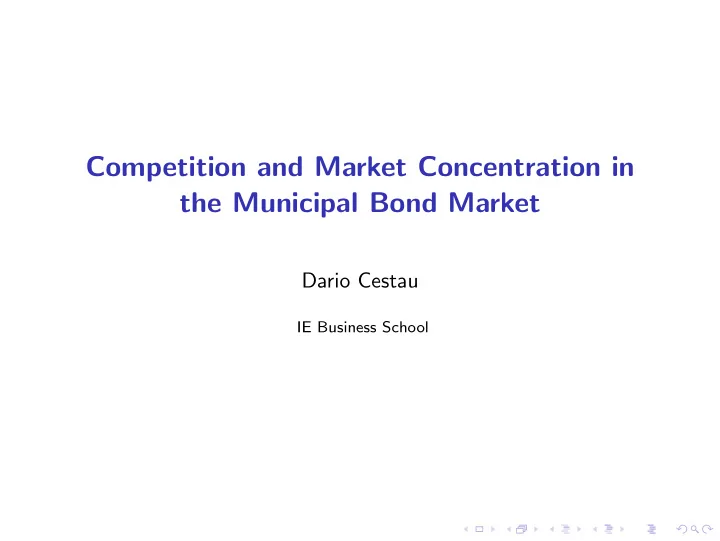

Competition and Market Concentration in the Municipal Bond Market Dario Cestau IE Business School
The municipal bond market ◮ Size: $4 trillion in notional value outstanding - near $500 billion issues per year. ◮ Despite its obvious economic importance, it’s far from efficient. ◮ Credit risk premiums are disproportionately high. ◮ The Liquidity is very low, and the liquidity premiums high. ◮ Implicit tax rates are too high. ◮ Market fragmentation and home bias. ◮ Yields deviate from the law of one price. ◮ Lack of pre-trade transparency. ◮ The financial backbone of the US’ infrastructure.
Public or Negotiated: which is better? ◮ Two main methods of sale: competitive/public or negotiated/private sale. ◮ The existing literature compares auctions to negotiated sales without taking externalities into account. ◮ Contribution: focus on externalities. ◮ Tragedy of the commons: negotiated sales may be more convenient for individual issuers, but less favorable if we consider the effects of the collective actions. ◮ I study whether negotiated sales increase the concentration in the market for underwriting services for municipal bonds.
Relevance: market power and the risk of collusion ◮ Market power: market concentration is usually correlated with market power. ◮ Risk of collusion: e.g. the City of Philadelphia antitrust lawsuit. ◮ Ongoing discussion: ◮ In 2018, Louisiana allowed the negotiated sale of muni bonds. ◮ In 2019, North Dakota increased the limit of negotiated sales.
Findings ◮ Market concentration has increased substantially over time, but only negotiated sales have contributed to greater concentration. ◮ The proportion of competitive sales in the state has a huge effect on concentration. ◮ Going from fully negotiated to fully competitive decreases the Herfindahl Index by 0.29. ◮ The change is equivalent to moving from highly concentrated to unconcentrated .
Final Sample ◮ Size: The sample contains 75,791 “deals” issued between 1990 and 2014 in 39 states. ◮ Issuers: independent school districts with taxing power. ◮ Type of obligations: long-term. ◮ Sub-sample: new-money bonds backed by an unlimited and separate ad-valorem tax plus the FFCT of the school. ◮ Why this sample? ◮ I want to compare apples to apples (Big-Macs). ◮ 2004-2014: 32% of all issues and 17% of notional amount.
Types of new-money school bonds General Obligations: # Cadval Ultd Dadval FF Bd 18 Ultd Dadval FF Bd 17,117 Abat Ultd Dadval FF Bd 5 Ultd Gadval FF Bd 7,940 GF Cp 1028 Ultd Dadval RV Bd 3,692 Ultd Dadval GF Cp 493 Ultd Dadval GF Bd 3,668 FF Cp 242 Ltd Gadval FF Bd 2,021 Ltd Dadval GF Cp 213 Staid Ultd Dadval FF Bd 1,492 Ltd Gadval FF Cp 77 Ltd Dadval FF Bd 1,135 Ultd Dadval FF Cp 71 FF Bd 445 Ultd Gadval FF Cp 14 Sales Ultd Dadval FF Bd 333 Revenue Bonds: # Ultd Cadval GF Bd 220 Ltd Sadval RV Bd 1,238 Ultd Dadval off FF Bd 169 Sales RV Bd 655 Sales Ultd Dadval GF Bd 74 Asmt RV Bd 439 Staid Ltd Dadval GF Bd 65 Ltd Cadval RV Bd 279 GF Bd 47 Ltd Gadval RV Bd 22 Ltd Dadval GF Bd 43 Fedaid RV Bd 10 Ltd Sadval FF Bd 63 AP Cp 2768 CF GF Bd 21 CF Cp 27
State Herfindahl Index: competitive vs. negotiated samples Full Sample New-money Ultd Dadval Period Neg Auc Neg Auc Neg Auc 1 0.22 0.12 0.22 0.14 0.31 0.14 2 0.22 0.11 0.24 0.12 0.28 0.12 3 0.26 0.13 0.28 0.13 0.30 0.13 4 0.28 0.12 0.32 0.12 0.31 0.11 5 0.32 0.12 0.35 0.15 0.39 0.13 ◮ The difference in concentration between the competitive sample and the negotiated sample is huge. ◮ Concentration has only increased in the negotiated sample.
Selection Bias - Bond legislation on the Method of Sale ◮ Issuers have a choice → subject to selection bias. ◮ Most state laws also provide for the method of sale of the bonds: ◮ Competitive ( restricted ). ◮ competitive or negotiated ( free ). ◮ There are 21,606 restricted deals in the sample. ◮ I compare concentration in the sample of restricted bonds and the sample of free bonds, regardless of the method of sales. ◮ No choice, no selection bias. ◮ I was assisted by more than 115 bond lawyers.
Robustness tests using state laws Full Sample New-money Ultd Dadval Period Free Rest Free Rest Free Rest 1 0.15 0.13 0.15 0.14 0.15 0.12 2 0.17 0.12 0.21 0.14 0.22 0.13 3 0.21 0.13 0.22 0.12 0.26 0.13 4 0.23 0.13 0.28 0.13 0.22 0.13 5 0.24 0.17 0.23 0.16 0.26 0.13 ◮ The difference in concentration between the free sample and the restricted sample is also huge. ◮ As expected, the difference is smaller than before because many free issuer use competitive sales anyway.
Robustness tests using exogenous state laws (2) Restricted Auctions vs. Free Auctions Full Sample New-money Ultd Dadval Period Free Rest Free Rest Free Rest 1 0.12 0.14 0.14 0.15 0.14 0.14 2 0.12 0.12 0.13 0.14 0.12 0.13 3 0.14 0.13 0.14 0.12 0.13 0.13 4 0.12 0.13 0.12 0.13 0.11 0.12 5 0.12 0.17 0.16 0.16 0.15 0.13 ◮ Bonds in the restricted sample are not systematically different from bonds in the free sample. ◮ Every period, concentration is the same for competitive sales in both samples. ◮ Final Remark : In the paper, I show overwhelming evidence that competitive sales reduce concentration by a large amount.
Recommend
More recommend